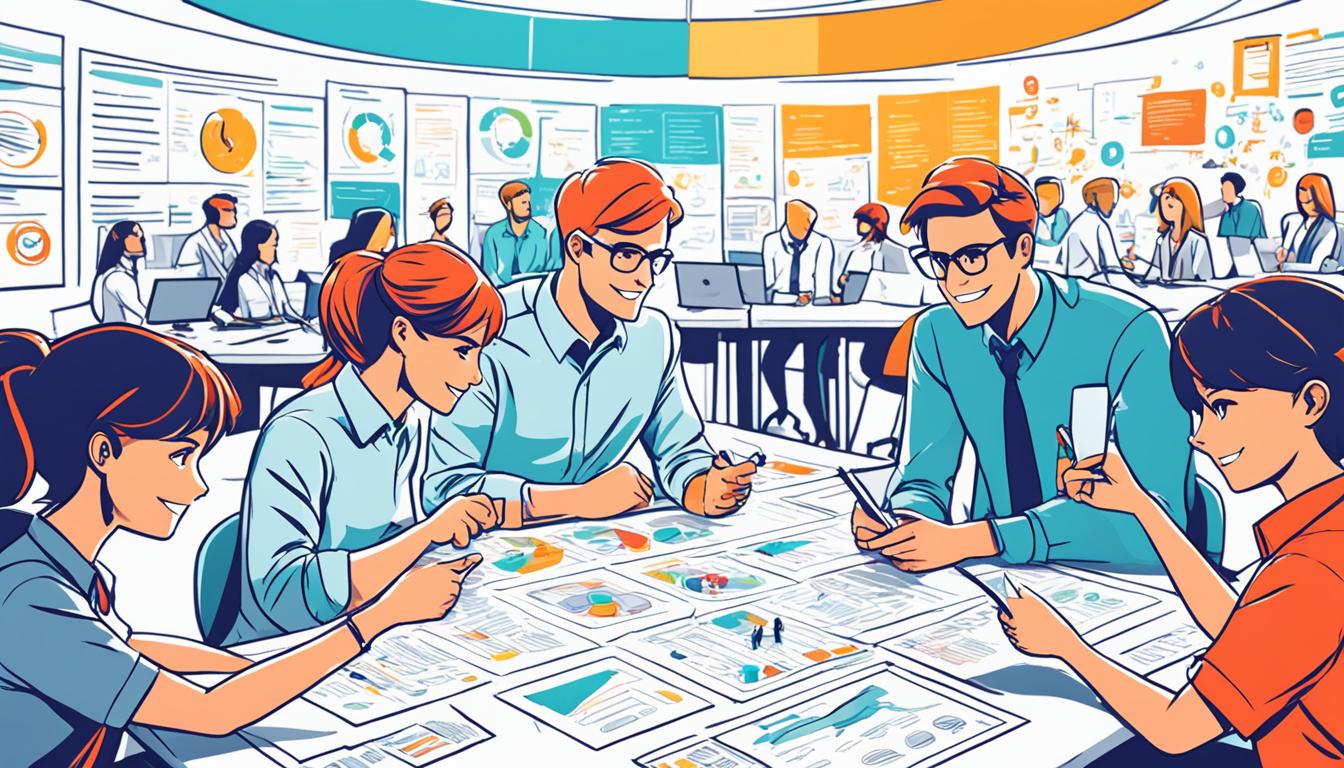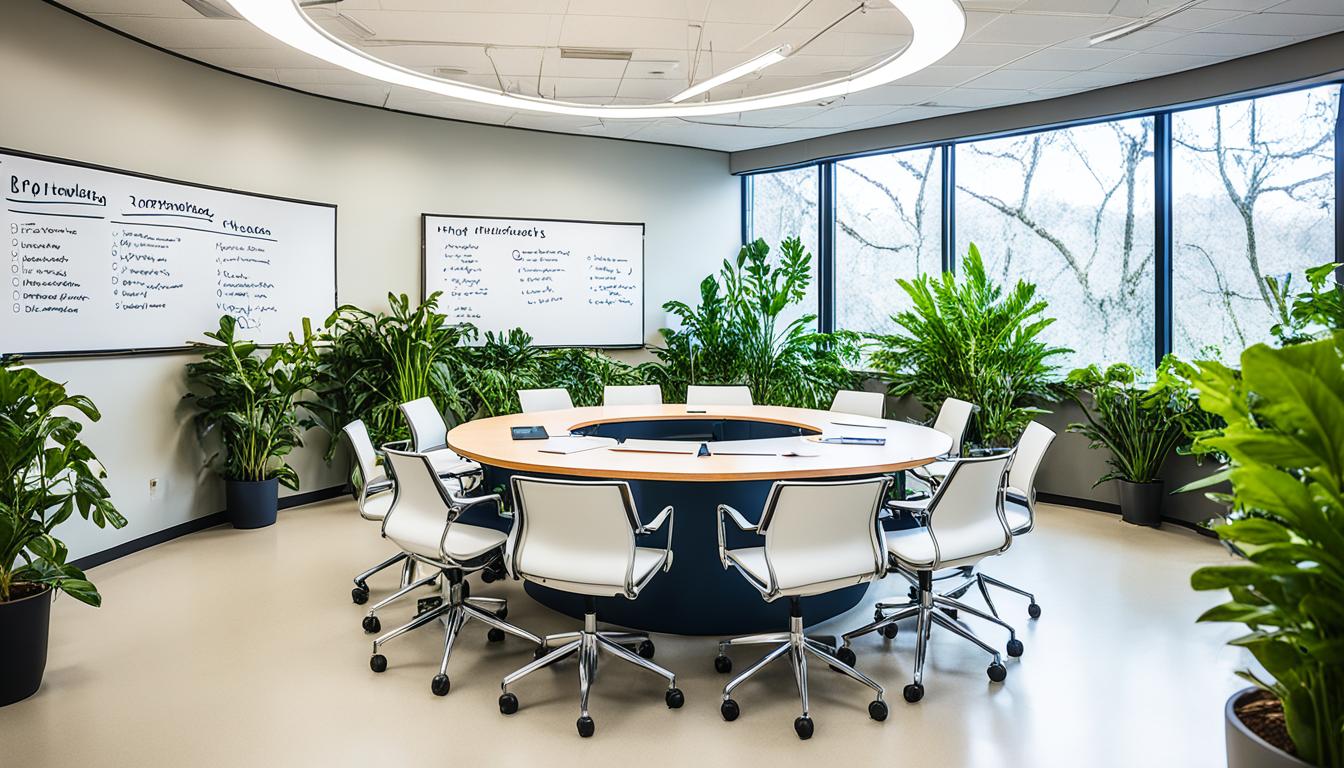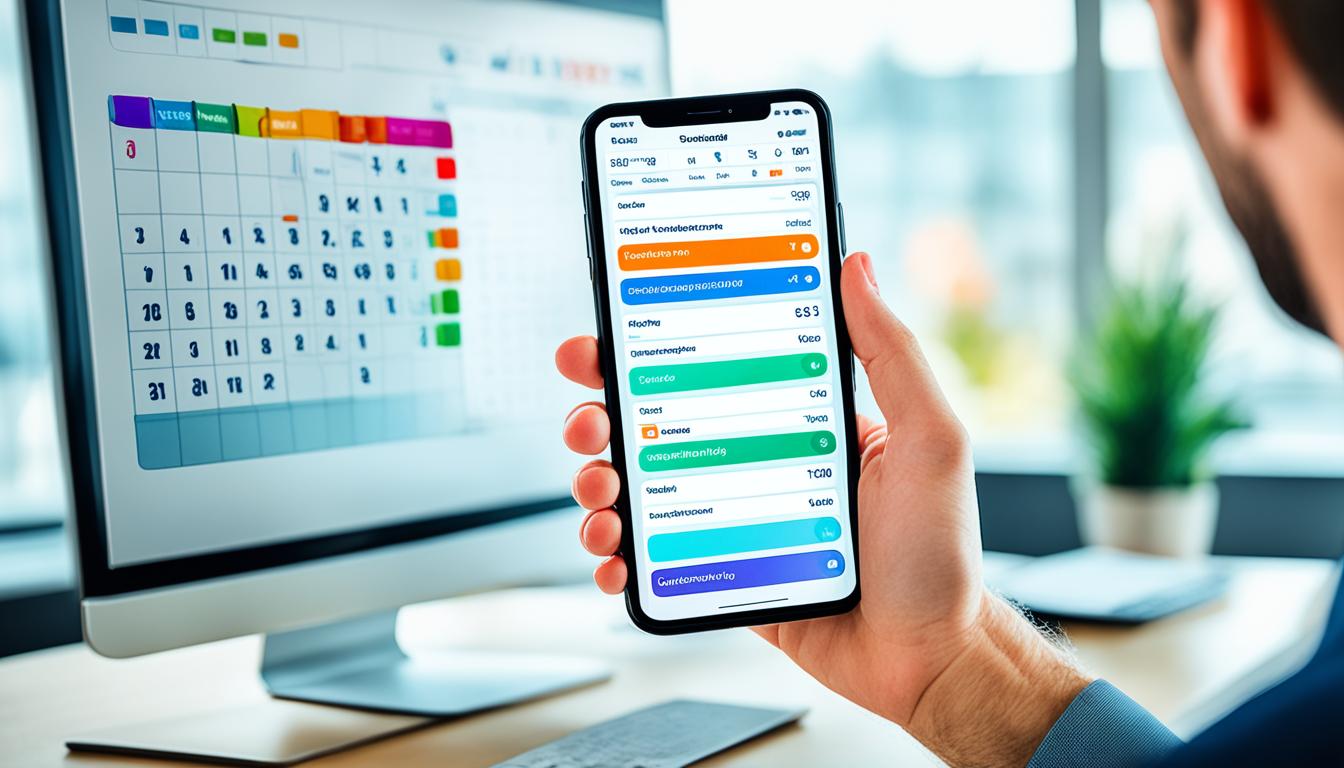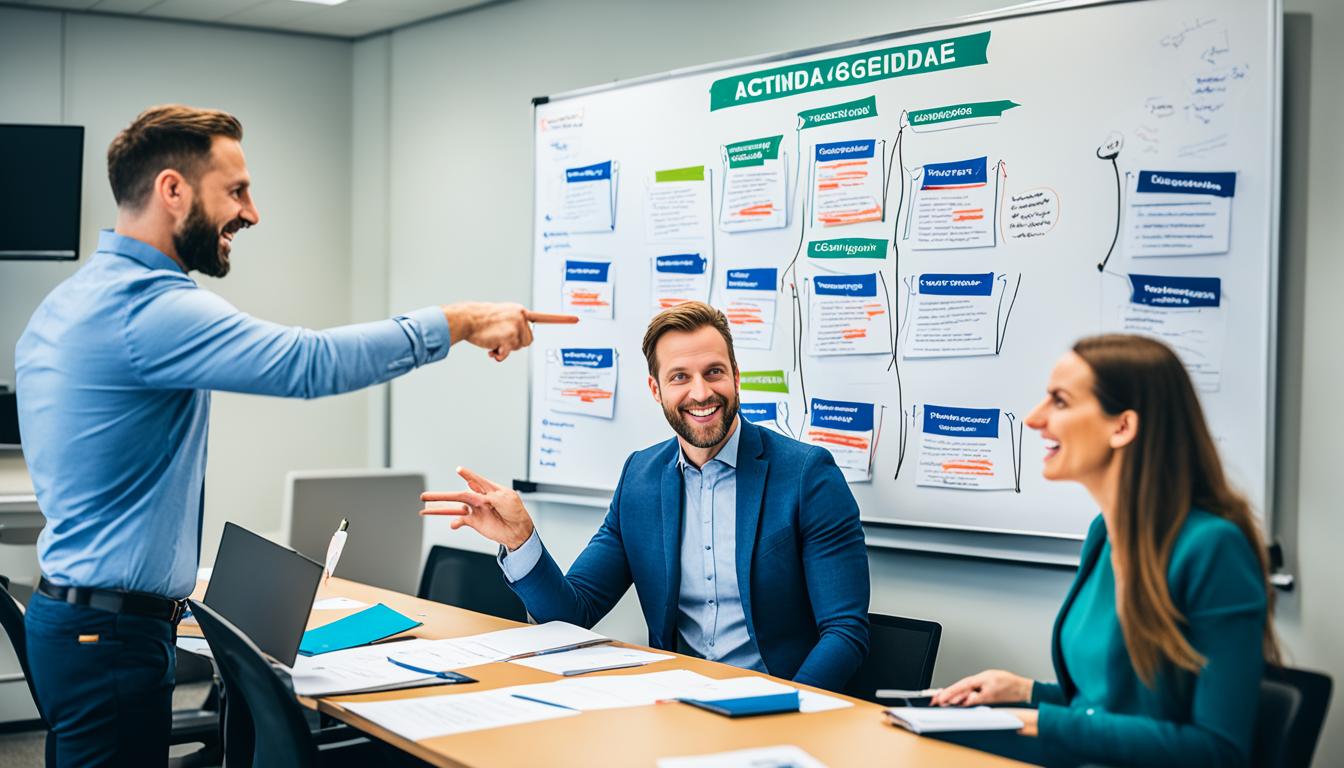
“The Efficient Meeting Checklist: How to Prepare and Execute””
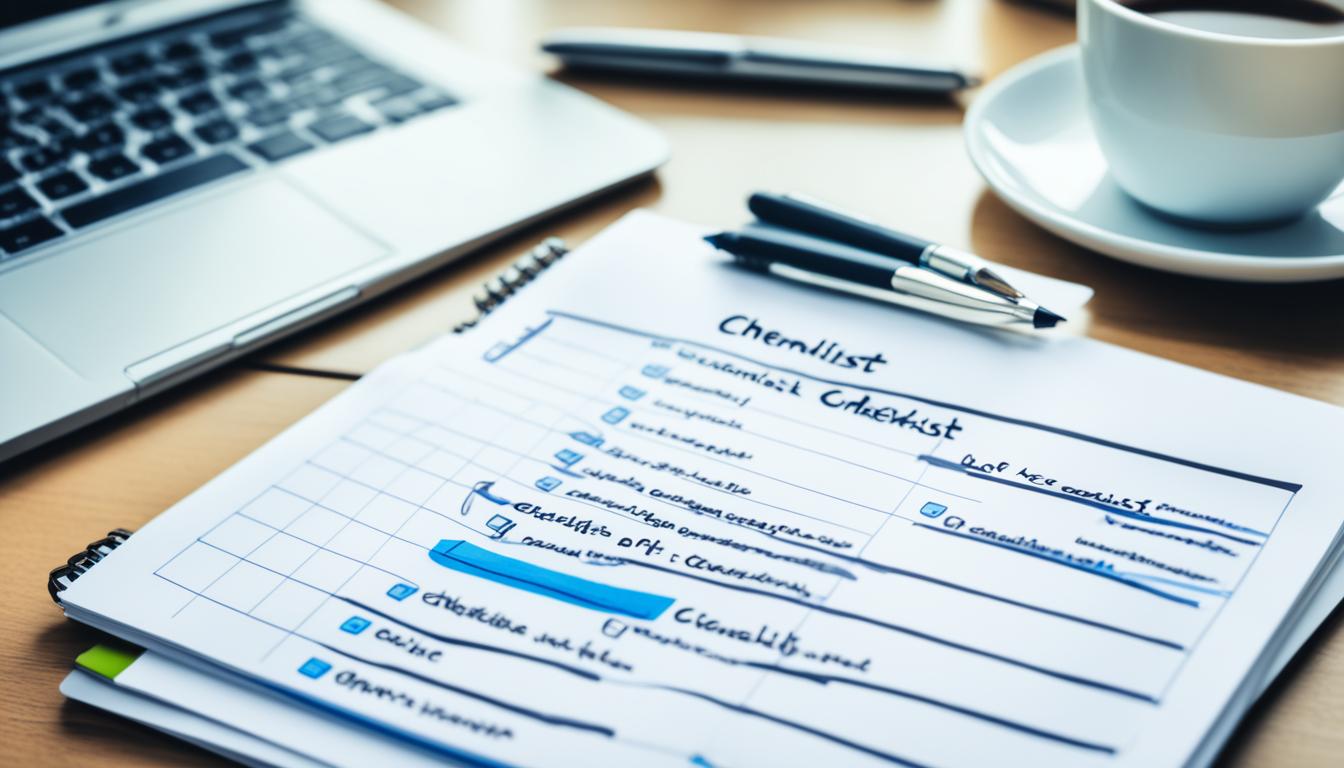
“Efficiency is doing things right; effectiveness is doing the right things.” – Peter Drucker
Meetings are a vital component of modern business operations, providing opportunities for collaboration, decision-making, and progress. However, without proper preparation and efficient execution, meetings can become time-consuming and unproductive. To ensure your meetings are effective and yield positive outcomes, it is crucial to follow a comprehensive checklist that covers every aspect of meeting preparation and execution.
Key Takeaways
- Efficiency is about doing things right, while effectiveness is about doing the right things.
- Proper preparation and execution are essential for productive and successful meetings.
- Follow a comprehensive checklist to guide you through every step of meeting preparation and execution.
- Ensure clarity of purpose, select the right participants, and set a solid cancellation policy.
- Address logistics, coordination, and technological requirements to facilitate a smooth meeting experience.
- Create an inclusive and diverse environment that fosters creativity and innovation.
- Establish ground rules for meeting etiquette and effective management.
- Utilize meeting management software, such as MeetingKing, to streamline the process and improve productivity.
The Critical Role of Meetings in Modern Businesses
Meetings play a vital role in the functioning of modern businesses. They serve as a platform for connecting departments, fostering collaboration, generating innovative ideas, and making collective decisions. However, the success of a meeting is not solely determined by the topics discussed or the number of attendees. To truly reap the benefits of a meeting, it must be productive, efficient, and well-executed.
Effective meetings are the cornerstone of successful businesses. They allow teams to align their goals, share relevant information, and brainstorm creative solutions. When executed properly, meetings can boost productivity, enhance team communication, and drive business growth.
So, what makes a meeting effective? It all starts with thorough planning and preparation. A clear purpose should be established, ensuring that the meeting’s objectives are well-defined and aligned with the organization’s goals. By setting specific goals, meeting organizers can focus the discussion and guide participants towards meaningful outcomes.
Furthermore, selecting the right participants is crucial for the success of a meeting. Inviting individuals who have a stake in the meeting’s topic and can contribute valuable insights ensures that the discussion remains relevant and productive. By including a diverse range of perspectives, businesses can leverage the collective wisdom of their teams, resulting in more well-rounded decisions and innovative solutions.
Additionally, an effective meetings policy should include a solid cancellation policy. This helps prevent unnecessary meetings and ensures that everyone’s time is respected. By setting clear guidelines for when a meeting should be cancelled or rescheduled, businesses can optimize their time spent in meetings and prioritize productivity.
Effective meetings are not just about discussing ideas, but also about driving action. By setting clear goals, selecting the right participants, and establishing a solid cancellation policy, businesses can foster a culture of productivity and achieve successful outcomes in every meeting.
Step 1: Preparation for the Meeting
Proper preparation is crucial for productive meetings. It helps focus on critical issues, saves time and resources, and shows respect for participants’ time.
In this step, you will go through the essential tasks to ensure a well-organized meeting. By following these best practices, you can maximize the effectiveness of your meetings and achieve better outcomes.
Identify the Purpose of the Meeting
Before scheduling a meeting, it is necessary to clearly define its purpose. Ask yourself: What do you want to achieve through this meeting? Is it to discuss a specific project, make important decisions, or brainstorm ideas? By identifying the purpose, you can set the direction for the meeting and ensure that it stays focused.
Assess the Necessity of the Meeting
Every meeting should be meaningful and necessary. Evaluate whether the objectives of the meeting can be achieved through other means such as email communication or a quick conversation. If a meeting is necessary, consider its duration and frequency. This assessment helps prevent unproductive meetings and allows you to make the most of everyone’s time.
Select Participants Thoughtfully
Choosing the right participants is vital for an effective meeting. Identify individuals who have direct involvement or expertise related to the meeting’s purpose. Avoid inviting too many people, as it can lead to information overload and dilute meaningful discussions. Select participants who can contribute valuable insights and actively engage in the meeting.
Create a Preliminary Agenda
A well-structured agenda sets the tone for a productive meeting. Outline the main topics to be discussed, allocate time slots for each agenda item, and specify any pre-meeting preparation required. Share the preliminary agenda with participants in advance, allowing them to come prepared and contribute effectively.
Proper preparation is the key to successful meetings. By identifying the purpose, assessing the necessity, selecting participants thoughtfully, and creating a preliminary agenda, you lay the foundation for an efficient and fruitful discussion.
Remember, meeting preparation is essential for the overall success of your meetings. By investing time in this initial step, you set the stage for focused, meaningful discussions that yield positive results.
Step 2: Preliminary Steps to Creating a Meeting
Before scheduling a meeting, it’s important to define its purpose and goals. This ensures everyone understands the objective and can prepare accordingly. Assessing the necessity of a meeting and selecting the right participants are also critical for its success. Creating a preliminary agenda helps set the stage for a well-prepared and engaging discussion.
Define the Meeting Purpose and Goals
In order to have a productive meeting, it is crucial to clearly define the purpose and goals. This provides a clear direction and ensures that all participants are aligned. When setting the purpose and goals:
- Specify the main objective or outcomes you want to achieve through the meeting.
- Break down the goals into smaller, actionable items to guide the discussion.
Having a well-defined purpose and goals helps keep the meeting focused and ensures that all participants are working towards the same objectives.
Assess the Necessity of the Meeting
Before scheduling a meeting, consider whether a meeting is truly necessary. Ask yourself:
“Can the same objectives be achieved through other means, such as email or a quick phone call?”
If a meeting is the most effective way to address the purpose and goals, proceed with scheduling. However, if the purpose can be achieved through alternative methods, it may be best to reconsider the need for a meeting, saving everyone valuable time.
Select the Right Participants
Choosing the right participants is essential for a productive meeting. Consider the following when selecting participants:
- Identify individuals who are directly involved in the meeting’s purpose and have relevant expertise and knowledge.
- Ensure representatives from all necessary departments or teams are included to promote collaboration and cross-functional perspectives.
- Avoid inviting unnecessary participants who may not contribute meaningfully to the discussion.
By carefully selecting the right participants, you can ensure that the meeting is focused, and all relevant perspectives are represented.
Create a Preliminary Meeting Agenda
A preliminary agenda serves as the backbone of the meeting by outlining the topics to be discussed. When creating a preliminary agenda:
- List the main discussion items in a logical order, considering their significance and relevance to the meeting’s purpose and goals.
- Include estimated time allocations for each agenda item to ensure efficient time management.
- Consider leaving room for open discussion or Q&A sessions, fostering engagement and participation.
Creating a preliminary agenda provides a framework for the meeting, helping participants prepare and ensuring that time is spent productively.
By taking these preliminary steps, you can set a solid foundation for a well-organized and productive meeting.
Step 3: Logistics and Coordination of a Meeting
Proper logistics and coordination are essential for a successful meeting. To ensure smooth planning and execution, consider the following:
1. Set the Meeting Time and Place: Determine a convenient time and location for the meeting. Take into account different time zones and the availability of participants. If it’s a virtual meeting, choose a platform that is accessible for all attendees.
2. Send Invitations and Pre-Reading Materials: Send out formal invitations to the participants well in advance, providing them with the necessary information, including the meeting’s purpose, agenda, and any pre-reading materials. This allows participants to come prepared and contribute effectively.
3. Determine the Decision-Making Process: Clarify the decision-making process for the meeting. Will it be a collaborative discussion followed by a vote, or will a facilitator make the final decision? Having clear guidelines ensures efficient decision-making during the meeting.
4. Provide Technical Instructions: If it’s a virtual meeting, ensure that participants have the required equipment and access to the chosen platform. Provide clear technical instructions to help participants join the meeting smoothly and avoid any unnecessary delays or technical difficulties.
| Meeting Logistics Checklist | Description |
|---|---|
| Set the meeting time and place | Determine a convenient time and location, or choose a virtual platform |
| Send invitations and pre-reading materials | Inform participants about the meeting’s purpose, agenda, and any materials to review beforehand |
| Determine the decision-making process | Clarify how decisions will be made during the meeting |
| Provide technical instructions | Ensure participants have the necessary equipment and access to the meeting platform |
By carefully managing meeting logistics and coordination, you can create a conducive environment for productive discussions and successful outcomes.
The Importance of Meeting Logistics and Coordination
Proper logistics and coordination are the foundation of a successful meeting. By setting the meeting time and place, sending invitations and pre-reading materials, determining the decision-making process, and providing technical instructions, you can ensure that all necessary arrangements are made, and participants are well-prepared. Effective meeting logistics and coordination contribute to smooth meeting execution and productive outcomes.
Step 4: Invite the Right People
Choosing the right participants for a meeting is crucial. It’s important to select individuals who are directly involved in the meeting’s purpose and can contribute meaningful insights. By including the right people, you can ensure that the meeting stays focused and productive.
When determining the meeting participants, consider the following:
- Select individuals who have the necessary expertise and knowledge related to the meeting’s agenda.
- Include key decision-makers who can provide valuable input and make informed judgments.
- Invite stakeholders who have a direct interest in the meeting’s outcomes.
- Consider including representatives from different departments or teams to encourage diverse perspectives.
Assigning clear roles and responsibilities to meeting participants enhances focus and engagement. By clearly defining each person’s responsibilities, you ensure that everyone understands their role in contributing to the meeting’s success. Some common meeting roles include:
- Moderator: Facilitates the meeting, ensures agenda adherence, and encourages active participation.
- Scribe: Takes notes and records important discussions, decisions, and action items.
- Timekeeper: Monitors the meeting’s progress and ensures discussions stay on schedule.
- Contributor: Actively participates in the meeting by providing insights and offering valuable contributions.
- Expert: Provides specialized knowledge or expertise on a specific subject matter related to the meeting.
By assigning these roles, you establish structure and accountability within the meeting, ensuring a smooth and productive flow.
Meeting Etiquette and Effective Management
When it comes to productive meetings, following proper meeting etiquette is essential for creating an efficient and respectful atmosphere. By embracing key principles such as punctuality, active listening, and respect for opinions, you can contribute to the success of the meeting. Additionally, effective meeting management plays a crucial role in maximizing productivity and maintaining focus throughout the discussion.
Adhering to the meeting agenda is vital, as it ensures that all topics are covered within the allocated time. By setting clear tasks and action items, participants can leave the meeting with a clear understanding of their responsibilities, promoting accountability and progress towards goals. Furthermore, disruptions during meetings can hinder productivity, so addressing them in a polite and efficient manner is important.
Here are some best practices for meeting etiquette and effective management:
- Be Punctual: Arriving on time demonstrates respect for others’ time and contributes to a streamlined meeting.
- Practice Active Listening: Paying attention to others’ viewpoints and opinions fosters a collaborative environment.
- Avoid Distractions: Minimize interruptions from electronic devices and other distractions to maintain focus.
- Respect Opinions: Encourage diverse perspectives and value everyone’s input, promoting a culture of inclusivity.
- Ensure Active Participation: Engage in discussions, ask questions, and contribute constructively to the meeting.
“Active listening is the key to effective communication. Only by fully engaging with others’ ideas and perspectives can we generate meaningful outcomes during meetings.”
Meeting management requires attention to detail to ensure that all objectives are met. By considering meeting interruptions and addressing them promptly, you can maintain the momentum and focus of the discussion. Effective meeting management establishes a conducive environment for collaboration, decision-making, and problem-solving.
Dealing with Meeting Interruptions
Occasionally, interruptions may occur during meetings, which can disrupt the flow and productivity. It is important to address such interruptions efficiently and respectfully to maintain the meeting’s effectiveness. Here are some strategies to handle common meeting interruptions:
| Interruption | Strategy |
|---|---|
| Side Conversations | Politely redirect the discussion back to the main topic, reminding participants of the agenda. |
| Excessive Talking | Use active listening techniques to acknowledge the speaker’s input, then steer the conversation towards other participants to ensure a balanced discussion. |
| Digital Distractions | Encourage participants to keep electronic devices on silent mode and refrain from checking messages or emails during the meeting. |
| Latecomers | While acknowledging the latecomer’s arrival, avoid rehashing previous discussions and provide a brief summary of what has already been covered. |
By adhering to meeting etiquette and implementing effective management strategies, you can contribute to creating a productive and efficient meeting environment. These practices foster collaboration, enhance decision-making, and ensure that the meeting achieves its intended objectives.

Inclusion and Diversity in Meetings
Inclusion and diversity are crucial aspects of productive meetings. Fostering an inclusive environment, where everyone feels valued and respected, leads to better engagement and more diverse perspectives. To ensure meeting inclusion, there are several key considerations to keep in mind.
Language Sensitivity
Using inclusive language during meetings helps create an atmosphere where everyone feels comfortable expressing their thoughts and ideas. Avoiding gendered language, using inclusive pronouns, and being mindful of cultural sensitivities can promote inclusivity and respect for all participants.
Equal Opportunity for Participation
Encouraging equal participation among meeting attendees is vital for inclusivity. Providing opportunities for everyone to contribute and share their perspectives ensures that diverse voices are heard and respected. Implementing round-robin techniques, where each participant gets a turn to speak, promotes an inclusive discussion.
Accessibility Considerations
Meeting organizers should take into account accessibility needs to ensure that all participants can fully engage. This includes considering physical accessibility, such as providing wheelchair-accessible venues or virtual platforms that accommodate individuals with disabilities. Additionally, providing materials in different formats, such as braille or audio, can enhance inclusivity.
“Inclusive meetings embrace diversity and create a safe space for individuals to share their unique insights.” – Jane Thompson, Diversity and Inclusion Consultant
Creating an inclusive meeting environment is not just the right thing to do, but it also leads to more effective and successful outcomes. When individuals from diverse backgrounds feel comfortable contributing, it fosters a culture of collaboration, creativity, and innovation.
Diversity of Thought
Encouraging diverse perspectives and ideas is essential for driving innovation and problem-solving. By actively seeking input from individuals with varied experiences, organizations can benefit from a broader range of insights and challenge conventional thinking. Emphasizing the value of diversity of thought in meetings contributes to more robust decision-making and better outcomes.
To exemplify the impact of inclusion and diversity in meetings, consider the following table:
| Inclusive Meeting Approach | Result |
|---|---|
| Welcoming diverse perspectives | Increased creativity and problem-solving abilities |
| Promoting equal participation | Enhanced engagement and commitment from all participants |
| Implementing accessibility measures | Full participation from individuals with disabilities |
A study by Smith et al. found that inclusive meetings, where diverse perspectives were actively sought and valued, led to increased innovation and improved decision-making. Inclusive meetings enable organizations to unlock the full potential of their teams and drive positive change.
In conclusion, fostering inclusion and diversity in meetings is not only a moral imperative but also a strategic advantage. By embracing different perspectives, creating an environment that values equal participation, and implementing accessibility measures, organizations can cultivate a culture of inclusivity and harness the power of diversity for continued success.
Meeting Ground Rules
Setting ground rules for meetings is essential for maintaining a productive and respectful environment. By establishing clear guidelines, you ensure that meetings stay focused, efficient, and effective. Here are some effective meeting ground rules to consider:
- No Cell Phones: Encourage participants to keep their cell phones on silent or switch them off during the meeting. This helps minimize distractions and keeps everyone engaged.
- Proper Preparation: Emphasize the importance of preparing for the meeting in advance. Participants should review any pre-reading materials, familiarize themselves with the agenda, and come prepared with relevant information or updates.
- No Side Conversations: Ask attendees to avoid having side conversations during the meeting. This ensures that the discussion remains focused and inclusive for everyone.
- Expectation of Participation: Make it clear that attendance implies active participation. All participants should contribute their ideas, opinions, and suggestions to the discussion.
Implementing these ground rules will help create a respectful and efficient meeting space, ensuring that everyone’s time and efforts are maximized. Remember, effective meeting rules are key to achieving successful outcomes.
The Facilitate Efficient Meeting Checklist
This meeting checklist is designed to help you facilitate efficient meetings by providing a comprehensive set of steps for preparation, conduct, and follow-up. By following this checklist, you can ensure that your meetings are focused, productive, and yield desired outcomes.
Preparation
- Define a clear meeting goal or objective to guide the agenda and discussions.
- Select the right participants who are directly involved and can contribute valuable insights.
- Distribute the agenda and any pre-reading materials well in advance to ensure everyone is prepared.
Conduct
- Start the meeting on time and set expectations for punctuality.
- Encourage active participation and ensure everyone’s opinion is respected and heard.
- Manage time effectively by sticking to the agenda and avoiding tangents or unnecessary discussions.
“Efficient meetings allow for focused discussions and timely decision-making.”
Follow-up
- Assign clear action items with deadlines to ensure accountability and follow-through.
- Track the progress of tasks and provide updates or reminders as necessary.
- Review the meeting outcomes and evaluate the effectiveness of the decisions made.
By utilizing this meeting checklist, you can streamline your meeting processes and increase overall efficiency. It helps you define clear goals, select the right participants, distribute agendas, manage time effectively, and ensure follow-up actions are taken. Incorporating these best practices will lead to more productive meetings and better outcomes for your business.
Sign up for MeetingKing
Looking for a reliable meeting management software to streamline your meeting processes and boost efficiency? Look no further than MeetingKing. With MeetingKing, you can efficiently handle all stages of your meetings, from preparation to follow-up, ensuring that every meeting is well-organized and successful.
MeetingKing offers a range of features that will revolutionize the way you conduct meetings. Here are just a few benefits you can expect:
- Effective meeting preparation: MeetingKing provides tools to help you create clear agendas, set goals, and select participants who are essential to achieving the meeting’s objectives.
- Streamlined meeting execution: With MeetingKing, you’ll have access to a user-friendly interface that allows you to manage meeting discussions, assign tasks, and ensure everyone stays on track.
- Efficient follow-up: Say goodbye to missing action items and accountability issues. MeetingKing helps you track tasks, set deadlines, and send automated reminders, ensuring that all meeting outcomes are properly addressed.
Using MeetingKing alongside our efficient meeting checklist will help you optimize your meeting processes, save time, and improve overall productivity. Don’t let inefficient meetings drain your resources—sign up for MeetingKing today and experience the difference it can make!
Customer Testimonial
“MeetingKing has transformed the way we conduct meetings in our organization. The software’s intuitive features and seamless integration have made our discussions more focused, decisions more structured, and follow-up more efficient. We couldn’t be happier with the results!”
– Mark Johnson, CEO of XYZ Corporation
MeetingKing Pricing
| Plan | Features | Price |
|---|---|---|
| Basic | Meeting agenda creation, task assignment, follow-up reminders | £9.99/month |
| Pro | Advanced collaboration features, customizable templates, analytics | £19.99/month |
| Enterprise | Custom branding, unlimited users, priority support | Contact us for a quote |
Conclusion
Efficient meetings are essential for maximizing meeting productivity and achieving successful outcomes. By following the steps outlined in the efficient meeting checklist and adhering to meeting etiquette, you can ensure that your meetings are well-prepared, effectively executed, and yield positive results.
Proper preparation is key to meeting success. By setting clear goals, selecting the right participants, and creating a well-defined agenda, you lay the foundation for a productive discussion. Meeting logistics and coordination, including choosing the right platform and providing necessary materials in advance, further contribute to the efficiency of your meetings.
Additionally, meeting management and adherence to ground rules help maintain focus and ensure active participation. By assigning roles and responsibilities, addressing disruptions promptly, and fostering inclusivity and diversity, you create an environment that promotes collaboration and the sharing of diverse ideas.
To further enhance your meeting efficiency, consider utilizing MeetingKing, a meeting management software that streamlines the entire meeting process. With MeetingKing, you can implement the efficient meeting checklist, track action items, and ensure accountability for follow-up tasks, saving time and resources.




















